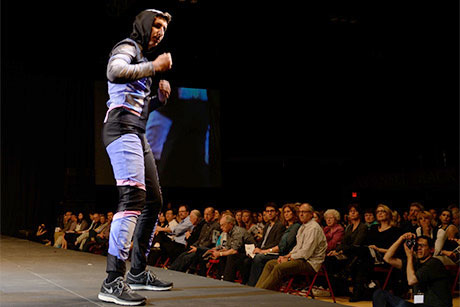Wearable technologies flourish as functional fashion
By Blaine Friedlander

In the heat of competition, these sporty clothes help keep you cool.
Cornell students in the Department of Fiber Science & Apparel Design have incorporated the comfort and sensibility of athletic wear with fabric that senses body temperature and can help determine whether an athlete is overheated.
Using thermochromic pigments (leuco dyes) applied on polyester fibers, an athlete can know instantly when he or she is getting hot.
“Different parts of the body get hot in different ways and at different times, so we’ve designed a color body suit that turns white when parts of your body overheat,” said Sarah Meyers ’16, a fiber science major in the College of Human Ecology.
The activewear team created a hoodie with Spandex leggings, shorts and a sleeveless shirt. The outfit debuted as a component of the “wearable technology” segment at the April 12 Cornell Fashion Collective runway show in Barton Hall. Team members include Meyers; Alicia Potuck, a graduate student in the field of chemistry; Ariana Levitt ’15, fiber science; and designer Eric Beaudette ’16, fiber science.
Thermochromic pigment starts as a powder. The students removed the polyester fabric’s coating and painted it with a pigment powder slurry. During exercise the human body generates heat and the garment begins to work; when the fabric reaches its activation temperature, portions of the garment go from colorful to colorless.
To test their creation, the students put the active clothes on “Walter,” the world’s first sweating fabric mannequin. Walter, created by Jintu Fan, professor and chair of Fiber Science & Apparel Design, enables researchers to test the thermal comfort of clothing under different climatic conditions.
Another student tech team provided lighting to technical clothing at the fashion collective. Lina Sanchez Botero, a doctoral candidate in the field of fiber science, and Beaudette designed clothes using wearable LEDs, electroluminescent (EL) tape and wire, conductive thread, 3-D printed accessories and small microcontrollers.
“As we look toward futuristic clothing, we believe that wearable technology will continue to integrate with athletic apparel to create multifunctional smart garments with extremely varied applications,” said Beaudette.
Innovations in light technology have become flexible, so that clothes fused with it don’t lose mobility, said Botero. The students worked with Architects of Intelligent Apparel at Myant Capital Partners for production of electroluminescent tape.
“Items like phones or computers will have more interactions with humans through clothing,” Beaudette said. “Reflective materials and lighting technologies, such as the flexible EL tape, will continue to be put in active wear, not just for exercise purposes, but to efficiently solve common problems.”
Media Contact
Get Cornell news delivered right to your inbox.
Subscribe